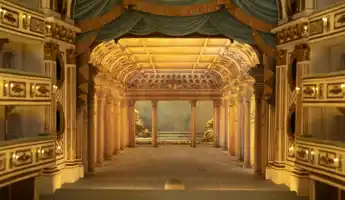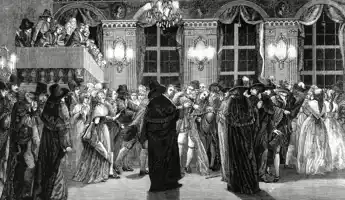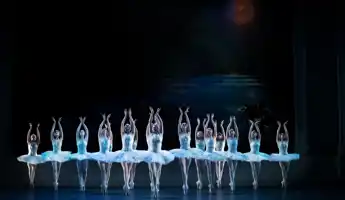The Royal Swedish Opera is Sweden's national stage for opera and ballet and was founded by King Gustav III in 1773.
The beginning
The Royal Swedish Opera is Sweden's national stage for opera and ballet. And it has been since January 18, 1773, when the first performance was given at the "Kongl. Opera". A few years earlier, in 1771, King Gustaf III had dismissed the French opera troupe that for twenty years played in the so-called "Bollhuset" (basically a tennis court) at Slottsbacken in Stockholm. This is because Gustav III wanted to create a Swedish ensemble that could perform Swedish operas.
The Swedish troupe continued to play in Bollhuset, but in 1782 a new opera house was ready and the ensemble could move in.

Gustav III's opera house
On September 30, 1782, the new Royal Theater House, designed by the architect Carl Fredrik Adelcrantz, was inaugurated. At the inauguration, a performance of Kraus's opera Aeneas in Carthago was actually supposed to be shown, but the female soloist who was to play the role of Dido had left the country with her husband to escape from creditors! Instead, Naumann's Cora and Alonzo was performed with text by G J Adlerbeth. Both the opera and the new opera house received a standing ovation.
During the 19th century, the opera house was considered one of the most beautiful buildings in Stockholm. This Gustavian opera house held 948 spectators and the auditorium was decorated in blue, white and gold.

Unlike in today's opera houses, the royal box was in the middle of the first row for the best possible view of the stage. Gustav III had a burning interest in opera, dance and theater and paid for the Opera's operations with his own funds.
Even dance was given its place at the Opera House. The first ballet to be staged was Louis Gallodier's Tillfälle gör Tjufven, a work that the Royal Swedish Ballet staged again in 2009 after nearly 200 years.
Gustav III is assassinated in his own theater
Barely ten years after the inauguration, on March 16, 1792, the king was shot at a masquerade ball at the opera and died as a result on March 29. This event is actually the basis of Verdi's opera Un ballo in maschera. The Gustavian opera house stood for another hundred years after the king's death, but by then the building was so worn, outdated and at risk of fire, that in 1892 it was decided to demolish it.

The new opera house
The exterior of the new house was built in the Neo-Renaissance, while the stairwell, the foyer and the auditorium received a neo-Baroque design. Marble from Norway was used in the entrance hall to establish the then union with our neighboring country. The Golden Foyer with ceiling paintings by Carl Larsson is reminiscent of the Opera Garnier in Paris.
The new opera house was inaugurated by King Oscar II on September 19, 1898. During the opening night, works by Swedish composers were performed; Adolf Fredrik Lindblad's Frondörerna, scenes from Franz Berwald's Estrella di Soria and finally a completely newly composed opening cantata by Ivar Hallström as a tribute to the past and to the old building.
The 1898/99 season continued on the Swedish line, with Wilhelm Stenhammar's Tirfing and Andreas Hallén's Valdemarsskatten as the only premieres.
In 1989, after almost 100 years as a well-used opera building, the Opera underwent a major renovation. Then all the public spaces, from the main entrance to the opera auditorium, were washed, painted, re-gilded and repaired.
The Golden Foyer
Before the renovation, you could barely see what the artworks in the Grand Staircase and Gold Foyer represented because of all the smoke and soot from the city that had accumulated over the 91 years that had passed since the house was inaugurated. But today you can once again experience the opera house in all its original splendor. The Golden Foyer, on the 1st row level, has been restored to its exact inauguration condition, with gold stucco on the walls and ceiling, crystal chandeliers, large mirrors and with curtains and upholstery in Florentine gold brocade.
For some twenty years prior to the renovation of the public spaces, all the premises "behind the scenes" had been fitted out to turn the old 19th century building into an efficiently functioning modern theatre.
In the current Opera House, there are roughly 1,100 seats and a two-tonne chandelier hangs from the ceiling. In the ceiling there is also a large ceiling painting by the artist Vicke Andrén. If you look closely, you can see that one of the little angels is carrying a piece of paper with a drawing of the very opera house over whose audience it is hovering.
The Royal Swedish Opera has changed its Swedish official name twelve times. After initially being called "Kongl Operan", the name, after many minor variations on the same theme, became "Kungliga Teatern" (the Royal Theatre) at the beginning of the 20th century and more than three quarters of a century later. But from 1997 the official name is the Royal Swedish Opera. In the vernacular, the theater has always been called "The Opera".
Tours in Sweden and abroad
The Royal Opera frequently toured Sweden with opera productions during the 1920s and a few decades later. Since 1959, the tours have also extended outside the country, such as to Edinburgh, London, Montreal, Munich, Kiel, Wiesbaden, Seville, Dresden, Berlin, Paris, Nyslott/Savonlinna and Oslo.


